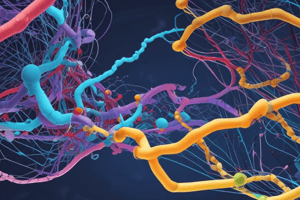Podcast
Questions and Answers
What is the primary difference between enzyme catalysts and chemical catalysts?
What is the primary difference between enzyme catalysts and chemical catalysts?
- Enzyme catalysts are regulated in their activity, while chemical catalysts are difficult to control
- Enzyme catalysts are produced by living cells and act inside living organisms, while chemical catalysts act outside living organisms
- Enzyme catalysts catalyze specific reactions, while chemical catalysts catalyze different reactions
- Enzyme catalysts are protein in nature, while chemical catalysts are non-protein in nature (correct)
How does enzyme catalysts catalysis occur compared to chemical catalysts?
How does enzyme catalysts catalysis occur compared to chemical catalysts?
- Enzyme catalysts are involved in the IUB system of nomenclature, while chemical catalysts are not
- Enzyme catalysts are difficult to control, while chemical catalysts have closely regulated activity
- Catalysis occurs via the active site of enzymes, while chemical catalysts catalyze as a whole (correct)
- Enzyme catalysts catalyze different reactions, while chemical catalysts catalyze specific reactions
According to enzyme nomenclature, what is the IUB classification of enzymes based on?
According to enzyme nomenclature, what is the IUB classification of enzymes based on?
- Solubility of the enzyme
- Size of the enzyme
- Type of reaction catalyzed (correct)
- Protein or non-protein nature
What is the suffix commonly added to substrates in enzyme nomenclature?
What is the suffix commonly added to substrates in enzyme nomenclature?
What is the primary difference between old tradition enzyme names and the IUB classification of enzymes?
What is the primary difference between old tradition enzyme names and the IUB classification of enzymes?
What is a key difference between enzyme catalysts and chemical catalysts?
What is a key difference between enzyme catalysts and chemical catalysts?
Which of the following best describes the IUB classification of enzymes?
Which of the following best describes the IUB classification of enzymes?
What is the primary purpose of adding the suffix ‘‘ase’’ to substrate in enzyme nomenclature?
What is the primary purpose of adding the suffix ‘‘ase’’ to substrate in enzyme nomenclature?
What distinguishes old tradition names of enzymes such as pepsin, trypsin, and renin from the IUB classification of enzymes?
What distinguishes old tradition names of enzymes such as pepsin, trypsin, and renin from the IUB classification of enzymes?
What characteristic differentiates enzyme catalysts from chemical catalysts in terms of their regulation and control?
What characteristic differentiates enzyme catalysts from chemical catalysts in terms of their regulation and control?
What distinguishes enzyme catalysts from chemical catalysts?
What distinguishes enzyme catalysts from chemical catalysts?
What is the primary purpose of adding the suffix ‘‘ase’’ to a substrate in enzyme nomenclature?
What is the primary purpose of adding the suffix ‘‘ase’’ to a substrate in enzyme nomenclature?
Based on the IUB classification of enzymes, what characterizes the type of reaction catalyzed by enzymes in Group 1?
Based on the IUB classification of enzymes, what characterizes the type of reaction catalyzed by enzymes in Group 1?
What differentiates old tradition enzyme names like pepsin and trypsin from the IUB classification of enzymes?
What differentiates old tradition enzyme names like pepsin and trypsin from the IUB classification of enzymes?
How does the regulation of enzyme catalysts differ from the regulation of chemical catalysts?
How does the regulation of enzyme catalysts differ from the regulation of chemical catalysts?
Flashcards are hidden until you start studying



